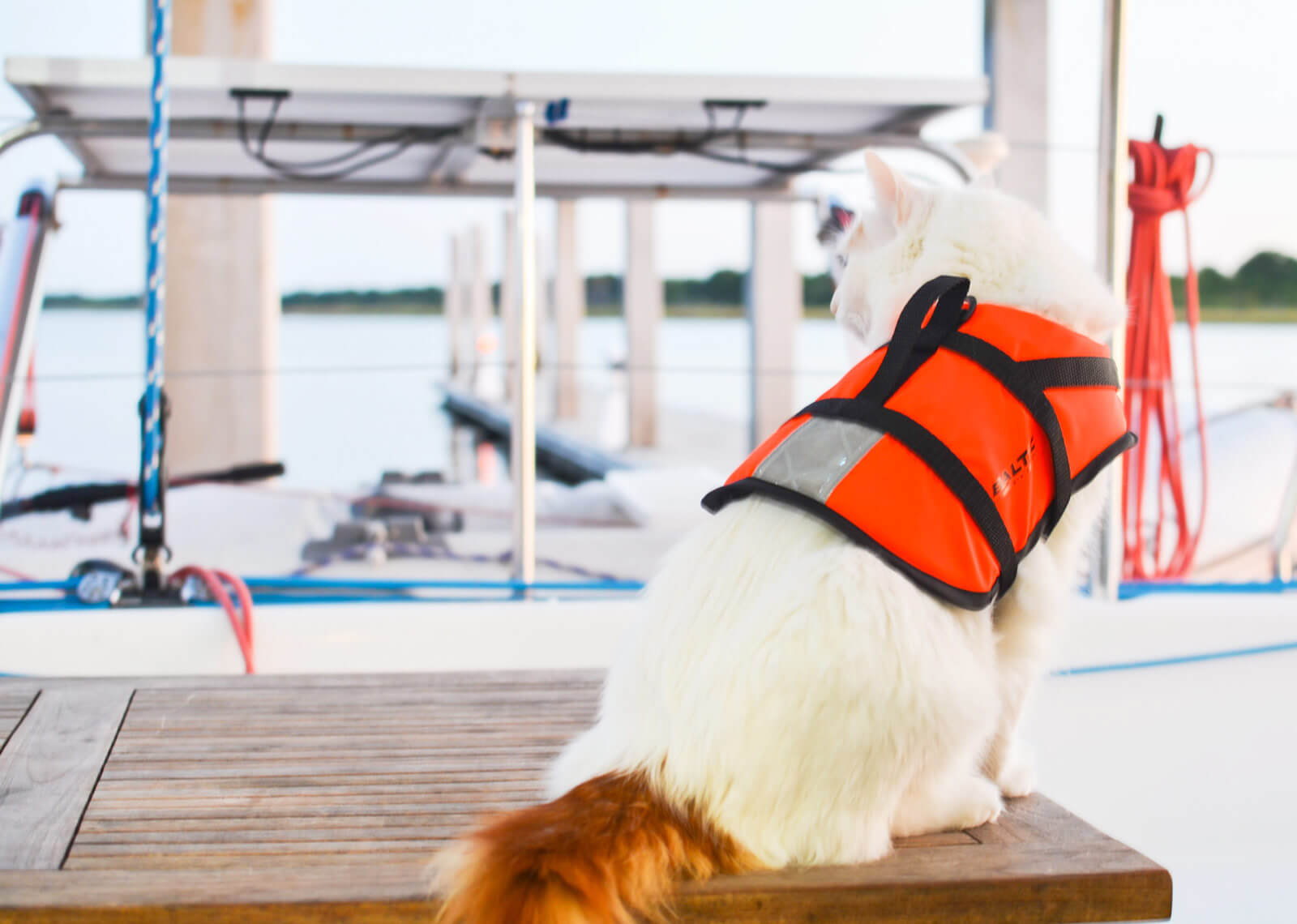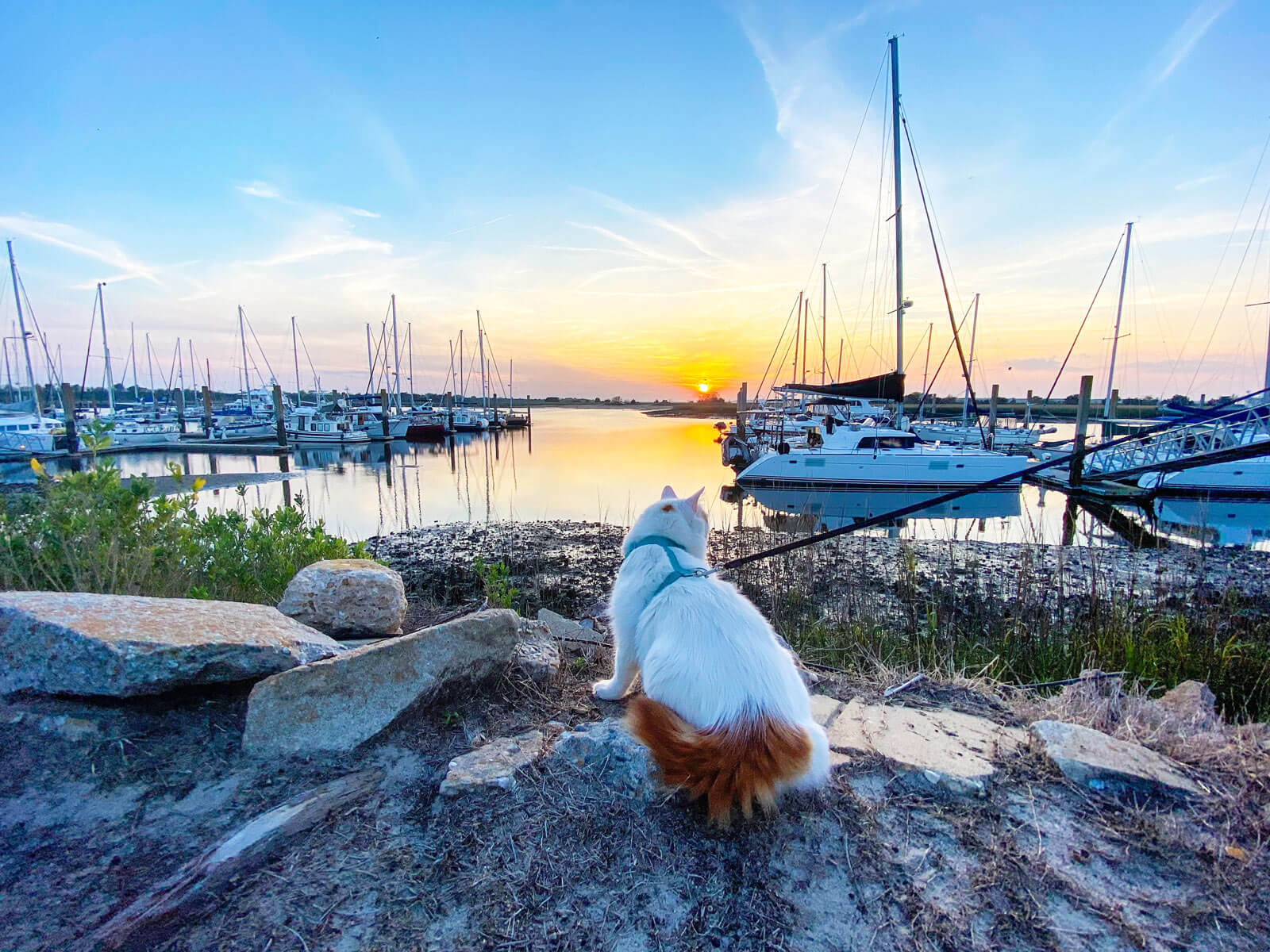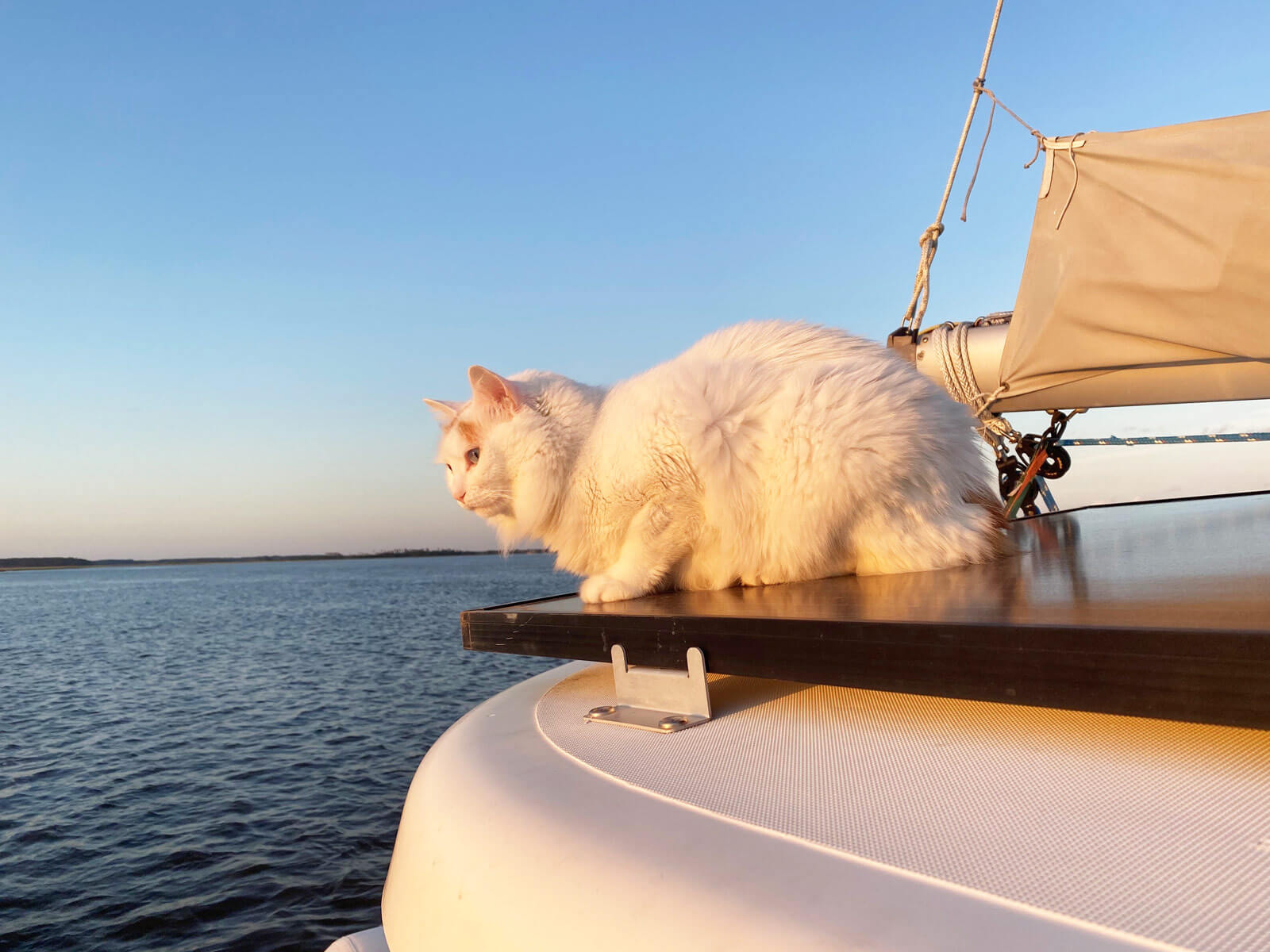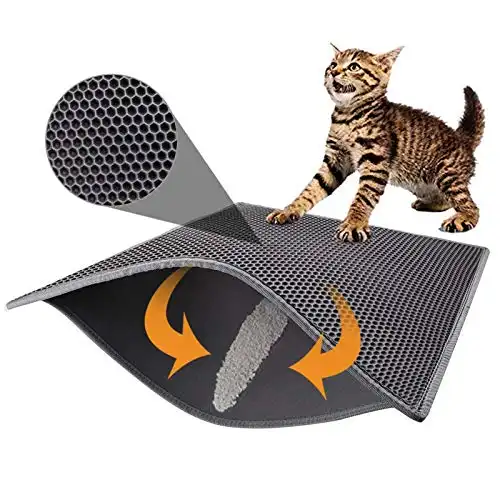Cat on a Boat 101: How to Sail and Live Aboard with Cats
As an Amazon Associate, we earn from qualifying purchases. We also earn from other affiliate websites. See our full disclaimer.

At first glance, having a cat on a liveaboard boat may seem like a lot of work and maybe not even possible. However, with patience and preparation having a cat on board can be a wonderful experience for both you and your feline first mate.
We’ll help you get started with prepping your boat for your cat’s arrival, finding gear you might need for your new liveaboard kitty, and how to keep your cat safe and healthy on board.
Getting Started with Your Boat Cat
Are you wondering if you can take a cat on a boat? I’m happy to report it is possible to turn your everyday house cat into a full-blown adventurous sailing cat.

Some kitties may take to boat life quicker than others, but eventually, most cats can become happy liveaboard boat cats with the right approach.
Introducing Your Cat to the Boat
We introduced our cat to our 38-foot sailing catamaran by having short visits (2-4 hours) while the boat was at the dock. We would work on the boat, and Augustus would come along and hang out. Once we moved onboard, he already felt comfortable in the space.

We would occasionally run the engines and let him get used to the sound. When we finally left the dock, he was still getting used to the engines and would find a spot down in the V-berth to hide. The more we traveled, the more comfortable Augustus became. He eventually started coming up on the bridgedeck, sitting in the windows and sometimes popping into the cockpit in calm seas.
No matter how accustomed your cat becomes to the boat, everyone is uncomfortable in rough conditions. Allow your cat some space since they might feel queasy.
Cat Proofing Your Boat
Cats are notably mischievous. If you don’t keep your wits about you, this can be a problem on a boat!
Any time we open a hole under a settee or open up a wall, Augustus is right there to see what’s happening.

Augustus has been stuck in the bilge for the better part of a day AND locked in a berth all night because the door swung closed. One time he even climbed through the settee in the bridgedeck and managed to pop out in an access hole under the bathroom sink in the starboard hull. The moral of the story – if you need to run a wire, get a cat!
But seriously – with a cat aboard, don’t leave any hole accessible. No matter how small, no matter how short a period.
Cats and Seasickness
Many cats are like humans. They feel sick for the first day or so on the water, and then they start to feel better.
Signs of seasickness in cats:
- licking lips a lot
- uneasy demeanor
- vomiting
Fresh air is as essential to them as it is to us. Getting them in the cockpit might help, but don’t push it if they are scared.
Most cats will find a spot to ride out the queasy feeling.
You can get anti-nausea medications from a vet for severe circumstances as a last resort.
Cruising with a Cat in Hot Climates
A question we often get is how do you keep your cat cool when sailing in hot climates.
Here are a few tips to keep your cat cool on hot days.
- wet bottom of paws, nose, and ears if the cat becomes overheated
- use wind scoops for airflow and leave hatches open with screens in to keep your cat inside but the air moving (we often use this setup on anchor when we go to shore)
Cat Food On Board
If you’re cruising on your boat, you’ll probably want to stock up on cat food just as you would other essential food items.
When we buy cat food, we get an 18-pound bag of dry food along with many cases of wet food.
To keep your cat’s dry food fresh, it must be in a sealed container. You don’t want moisture or any critters getting into that precious kitty food supply. Also, you don’t want your cat turning up their nose at stale kitty food halfway through the supply.

We use the Vault pet food storage container to keep cat food fresh and love it!
We also use a smaller container such as this one for daily feedings, so we aren’t constantly opening the long-term food storage container. This method helps keep the cat’s food freshest. We have never had any contamination with this system.
You might also want to consider a kitty food mat to ensure food and water bowls stay in place when underway. We like this mat from CatGuru. This works on a catamaran, but you might need to store the bowls when underway on a monohull.
Suggested Cat Food Products
Cat food and storage products we love for living on a boat.
PRO TIP: We like Chewy.com for ordering pet food on the go in the US. They offer 1-3 day shipping on orders over $50. You can order a few days ahead and have it shipped to a marina along your route.
The Litter Box
Managing a litter box is always a complex task, and it is especially challenging in a small space such as a boat.
Boats are usually in motion, don’t always offer an easy way to dispose of waste, and can be very humid.
Here are a few ideas for handling these obstacles.
- Invest in a top entry litter box to contain the litter
- Use a Litter Genie to store cat waste until you can dispose of it (it works just like a diaper genie)
- Find a location for the litter box that will have the least amount of humidity

Choosing a Litter
There doesn’t seem to be a perfect litter choice for cats on a boat. Every option has pros and cons. Below is the litter we use and another popular option from cruisers. Both of these options let you avoid carrying hundreds of pounds of litter around on your boat if you are cruising in remote waters.
- Breeze Cat Litter System – Boat owners seem to really like the Breeze Cat litter box. When the cat does its business, the pee falls through the box onto a pee pad below. The poop is scooped. Because the urine is separated, the litter pellets in the top of the box last a lot longer than the average litter. There are concerns about the price of the pee pads and the litter pellets. We’ve heard of cat owners who have bought 3rd party pads and have found ways to wash and reuse the pellets. There is a ton of information on this system if you search the Gatos Del Mar Facebook group.
- Pretty Litter – We have been using Pretty Litter for four years now. It’s nice because it lets you know if your cat has any health issues within the urinary tract. This synthetic litter is non-clumping, soaks up pee, and allows you to scoop the poop. It minimizes the amount of waste we add to the Litter Genie since it is non-clumping. However, it works by soaking up urine, which is not great for a humid environment and doesn’t last as long on a boat.
Suggested Cat Litter Products
Durable and long-lasting litter products we love for boat life.
NOTE: Some boat owners toilet train their cats to avoid dealing with a litter box onboard. Training can be a long process that requires patience, but it might be worth the effort, especially if you have a young cat who is eager to learn.
Gear for Cats on Boats
Boat and sailing cats need a few more pieces of gear than the average cat. Here are some items to help your kitty stay safe while still enjoying themselves on a boat.
Life Jackets for Cats
So when should your cat wear a life jacket? Short answer – it’s totally up to you.
Watch your cat closely in their first few months aboard. They will be finding their rhythm and testing their limits. This is the time when our cat took his first dip in the ‘drink’ (and he was without his cat life jacket). I would suggest putting the life jacket on your cat more often upfront until your cat becomes more familiar with boat life. Once they start getting their bearings, you can choose to put it on them less.

Can Cats Swim?
Most cats can swim. They just don’t particularly want to. Many cruisers will train their cat to climb a rope on the side of the boat if they fall over. Augustus could easily climb up on the sugar scoop of our catamaran in calm water, and that’s just what he did when he fell in at the dock.
PRO TIP: If your cat does fall in the water, make sure you bathe them. Marina water is especially dirty and can contain diesel fuel and “other things” that might come out of a boat. You don’t want them licking themselves without first getting a bath.
Cat Life Vest Suggestions
Cat life jackets are pretty hard to come by. Below are a few life vests designed specifically for cats that come highly recommended in the cat owner boating community.
Baltic Maja Pet Buoyancy Aid – A cat-specific life jacket with a smaller neck opening than what you see with most dog-designed jackets. It also has an extra strap underneath for more support.
Lyra Cat FFD (Feline Flotation Device) – A cat-specific life jacket similar to the Baltic but also has a built-in harness for extra comfort. This jacket was designed and tested by a sailing cat owner.
SurferCat Life Jackets – Another life jacket made just for cats. This one is designed by a pro wakeboarder who wanted something for their cat that is very minimal and built with performance and mobility in mind.
Cat Backpack or Carrier
You’ll want a way to transport your furry feline if you are living aboard.
We love our backpack carrier because it makes moving Augustus around in this lifestyle easier.

The backpack offers hands-free carrying on and off the boat. It’s a stable and safe carrier for our cat, whether we have to cab, walk, or bike to a vet or other location.
They even have backpacks that expand for comfort traveling in a vehicle. Search cat backpacks on Amazon here.
Harness and Leash
Harness training your cat is one of the best things you can do to make your and your cat’s new life easier on a boat.
It will allow you the freedom to take your cat for walks at the marina or dinghy them to shore for land time.

Once your cat is harness trained, don’t let your cat on deck or off the boat without a harness. This approach can keep your cat from darting out the door, and they will associate the harness with time outside.
We’ve used many different harnesses over the years. Here are a couple of our favorites:
PRO TIP: Make sure whatever harness you choose as an adjustable neck for the best fit.
Cat Trackers
A tracking device is another good idea when you have a cat that wanders off the boat in a marina or one that you take ashore.

The longer our stay in a marina, the more comfortable Augustus becomes venturing off the boat. Occasionally, he might slip by us and wander up the dock (or onto another boat) without anyone noticing.
Trackers are great for quickly locating your kitty on the dock or even finding them if they wander away from the marina.
Here are a couple of trackers we have used and our reviews of each.
|
Primary Rating:
4.4
|
Primary Rating:
3.8
|
|
N/A
|
N/A
|
|
Description: The Tile Pro is a Bluetooth tracker that is intended to track things like your keys, but we found it was an affordable option that worked well to track our cat. We attached it to the D-ring on the cat’s harness. The Pro version has a 400-foot range. |
Description: The Jiobit is a tracking device designed to track pets, children, and/or seniors. This device uses Bluetooth, Wifi, and a required cellular data plan to track the person or pet the most accurately while conserving battery life. |
|
Pros: |
Pros: |
|
Pros:
|
Pros:
|
|
Cons: |
Cons: |
|
Cons:
|
Cons:
|
The Tile Pro is a Bluetooth tracker that is intended to track things like your keys, but we found it was an affordable option that worked well to track our cat. We attached it to the D-ring on the cat’s harness. The Pro version has a 400-foot range.
- Inexpensive compared to other trackers
- Small and lightweight compared to most trackers
- Water-resistant
- The battery is easily replaced after months of use
- Within range, you can 'ring' the Tile to locate your cat
- Out of the 400-foot range, there is no tracking
- No directional tracking (you get status updates (‘moderate’ or ‘strong’ signal), but you can’t tell in which direction
The Jiobit is a tracking device designed to track pets, children, and/or seniors. This device uses Bluetooth, Wifi, and a required cellular data plan to track the person or pet the most accurately while conserving battery life.
- Track at any distance with the data connection
- Live tracking mode to view cat’s movement in real-time
- Can alert you when your cat leaves a designated area
- Small size compared to other GPS trackers
- Waterproof
- Requires a monthly data plan
- Needs charging once a week (on average)
- Live tracking mode will drain the battery quickly
- Data plan will not work outside of the U.S.
- Will scratch easily if you don’t purchase the optional cover/sleeve
PRO TIP: As a backup, we have Augustus microchipped (this is required to check into some countries). We also attach a pet ID tag to his harness with our phone numbers. We have also seen cat owners that have their contact and/or boat information embroidered into the harness. There are shops on ETSY that will do this for you.
Vet & Pet Health
Pet care can be a little tricky when you are traveling often. Especially on the water.
Here are a couple of tips to ensure your cat is taken care of.
- Always keep a good account of your cat’s health records. We keep a digital file so we can both easily access them. This way, when we visit a new vet, it’s easy to give them all the information they need.
- If you have pet insurance, make sure you are covered in the area you are traveling.
- Talk to your vet about putting together a kitty first aid kit

Traveling to Different Countries with Your Cat
If you are planning to travel to different countries on your boat, you’ll need to check each country’s requirements for cats.
Many countries will require a health certificate to enter the country. If you are going for a health certificate, you need an appointment for just the health certificate. The appointment can’t also be for a checkup or other issue. Most countries will also require a 1-year rabies shot (instead of a 3-year), FVPR, and possibly the feline leukemia vaccine.
Check noonsite.com for details on cat check-in requirements for different countries.
More Resources for Living Aboard with Cats
Luckily, there are quite a few people out there sailing with cats! You can find more information when you know where to look.

- As mentioned earlier, the Facebook group Gatos del Mar has a ton of great information about living on a boat with a cat. You can search this group for answers or ask questions.
- Instagram accounts also have great information. I love following Miss Rigby’s account on Instagram. Rigby is a boat cat that lives aboard with her owners full-time. I’ve messaged them before with sailing cat questions and they were very helpful!
- Adventurecats.org or the book Adventure Cats: Living Nine Lives to the Fullest – this organization has a lot of great info about harness training and traveling with your kitty!
READ NEXT: If you explore by land and water, you might also like the post How to Go RVing with Cats: A Complete Guide.
Final Thoughts on Boating with Cats
Cats are creatures of habit, but they are also very adaptable. Use the information you’ve gathered and set up a welcoming boat environment for your cat. Have patience and listen to your feline’s responses to their new home.
If you do these things, you and your cat can have some incredible experiences together on the water!
Want to learn more about what it’s like cruising on a boat?
View our guide to read more on life on a boat and what to expect living on the water.
Like this post? Save it on Pinterest for later.

















Love this site!
Thanks so much! Glad you are finding it helpful.